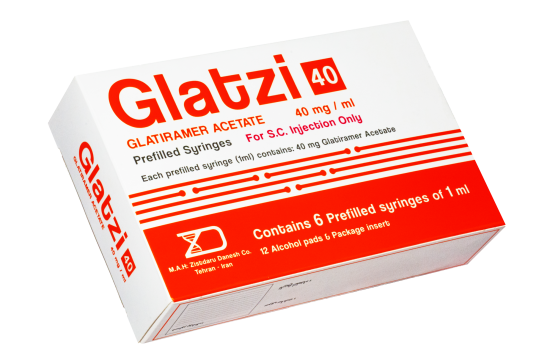1- What is Glatzi?
Glatzi contains the acetate salt of glatiramer that is a mixture of synthetic polypeptides.
2- Mechanism of Action
Little chains of proteins present in Glatzi are the same as proteins making myelin and it seems that by regulating the immune system function, they positively affect and control MS (Multiple Sclerosis).
3- Indications and Usage
Glatzi is indicated forthe treatment of relapsing forms of multiple sclerosis (MS), to include clinically isolated syndrome (CIS). relapsing-remitting disease (RRMS). and active secondary progressive disease (SPMS). in adults.
4- Dosage & Administration
For SUBQ administration in the arms, abdomen, hips, or thighs using prefilled syringe or an optional injection device; rotate injection sites to possibly minimize the occurrence of lipoatrophy. Do not administer IV. Administer the 40 mg dose on the same 3 days each week (e.g., Monday, Wednesday, Friday) at least 48 hours apart. Allow syringe to stand at room temperature for 20 minutes prior to injection.
Remember: Your doctor makes the right dosage for your use. Never change your dose or dosing schedule without informing your doctor. Never stop taking the medicine on your own or without talking to your doctor.
5- Dosage Form, Ingredients and Packaging
Glatzi is a sterile solution for injection in pre-filled syringes. Each pre-filled syringe consists of glatiramer acetate, mannitol and sterile water for injection. Glatzi is available in packs of six (6) pre-filled glass syringes, 6 alcohol pads and 1 package insert.
6- Warnings and Precautions
- Chest pain: May or may not occur with the immediate postinjection reaction; described as a transient pain usually resolving in a few minutes; often unassociated with other symptoms. Episodes usually begin ≥1 month after initiation of treatment.
- Hepatic toxicity: Liver failure and hepatitis with jaundice (sometimes severe) have occurred from days to years after initiation of therapy; consider discontinuation of therapy if signs and symptoms occur.
- Hypersensitivity reactions: Anaphylactoid reactions (rare) have been reported.
- Immune response: Although there has not been a systematic evaluation of glatiramer’s potential to affect other immune functions, it may interfere with recognition of foreign antigens undermining the body’s tumor surveillance and defense system against infection.
- Infections: In high-risk populations or in countries with high tuberculosis burden, screen for latent infections (e.g., hepatitis, tuberculosis) prior to initiating therapy. For patients who screen positive for latent infections, consult infectious disease or other specialists (e.g., liver specialists) regarding treatment options before initiating therapy.
- Lipoatrophy: May occur locally at injection site at various times after treatment (sometimes after several months) and may not resolve; to possibly minimize occurrence, advise patients to follow proper injection technique and rotate site with each injection. Skin necrosis has also been observed.
- Systemic reactions: Postinjection systemic reactions may occur immediately (within seconds to minutes of injection; majority of reactions observed within 1 hour) and in a substantial percentage of patients (~2%); symptoms (anxiety, chest pain, constriction of the throat, dyspnea, flushing, palpitations, tachycardia, urticaria) are usually self-limited and transient. These symptoms generally occur several months after initiation of treatment.
7- Contraindications
A history of sensitivity to glatiramer acetate or mannitoL
8- Concomitant use of Galatzi with other drugs
In case you take supplements, vitamin and herbal medicines while using Glatzi, inform your doctor of you medicine list.
9- How to use Glatzi
Before injecting Glatzi, make sure to fully read the instructions. Initial injection should be supervised by experienced and expert nurse and or your doctor. Patients should learn aseptic injection procedure and be evaluated periodically. Furthermore, they should be warned against the danger of reusing the needles and syringes and their safe disposal.
Instructions for use:
- Step 1: gather the materials
- Put all of the items you need on a clean, flat surface in a well-lit place.
- Glatzi pre-filled syringe (remove one blister pack for your single dose from the refrigerator)
- water and soap or alcohol pad (wipe)
- dry cotton ball
After removing the medicine carton from the refrigerator. let the medicine stand for at least 20 minutes to allow the solution to warm up to room temperature. Before injecting the medicine. wash and dry your hands. Avoid touching your hair or skin after washing to prevent infection.
Avoid expelling the air bubbles from the syringe.
- Step 2: choose injection site.
You should choose the injection site beforehand and inject in those sites regularly. Seven (7) suitable injection areas on your body are as follows:
- Arms: back of right and left upper arms
- Thigh: front of right and left thigh (about 5 cm above the knee and 5 cm below the groin)
- Hips: right and left area of upper hip
- Abdomen: within 5 cm of navel area
This figure illustrates the areas suitable for injection. Glatzi 40 users should choose one area for injection during the week. Each of the areas are divided to smaller areas and injection should be done in one of these smaller areas. Choose the new area that has not been used recently for injecting the medicine.
Remember not to inject in the area of skin that is:
- Painful
- Inflamed and/or mass
- Discolored
- Deformed
Repeated injection in the same area can worsen the condition. Self-injecting the medicine may be hard for you (for example, back of the arm). To learn how to self-inject in those areas, you can get help from special nurse for Glatzi.
- Step 3: Injection
- Remove the syringe from its protective blister pack and put
it on a flat clean surface.
- Clean the desired injection site on your body with an
alcohol wipe (let the site air dry for one minute).
- Pick up the syringe as you hold a pencil and remove the needle shield.
- Pinch about 5cm fold of skin between your thumb and index finger (as in the figure).
- Insert the needle at a 90-degree angle, resting your hand against your body. When the needle is all in, release the fold of skin.
- To inject the medicine, hold the syringe steady and push down the plunger (this should take a few seconds only).
- Pull the needle straight out.
- Press a dry cotton ball on the injection site for a few seconds.
- Dispose of the needle and the shield in a special plastic container (resistant to opening).
10- possible adverse effects More common adverse effects (more than%10)
Chest pain, vasodilation
Skin rash
Nausea
Type I hypersensitivity reaction
Development of IgG antibodies
Infection, influenza
Erythema at injection site, itching at injection site, pain at injection site, residual mass at injection site, swelling at injection site
Anxiety, pain
Asthenia, back pain
Dyspnea, nasopharyngitis
Common adverse effects: (1-10%)
Edema, facial edema, palpitations, peripheral edema, syncope, tachycardia
Erythema of skin, hyperhidrosis, pruritus, urticaria
Weight gain
Dysphagia, gastroenteritis, vomiting
Urinary urgency, vulvovaginal candidiasis
Benign skin neoplasm, lymphadenopathy
Hypersensitivity reaction
Atrophy at injection site, fibrosis at injection site, hypersensitivity reaction at injection site, inflammation at injection site, lipoatrophy at injection site
Chills, migraine, nervousness, speech disturbance
Laryngospasm, tremor
Diplopia
Bronchitis, cough, flu-like symptoms, rhinitis, viral respiratory tract infection
Fever
11- Use in Specific Populations
Pregnancy:
Available human data on the use of Glatiramer acetate in pregnant women are not sufficient to support conclusions about drug-associated risk for major birth defects and miscarriage.
Lactation:
There are no data on the presence of glatiramer acetate in human milk, the effects on breastfed infants, or the effects on milk production.
Pediatric Use:
The safety and effectiveness of Glatiramer acetate have not been established in patients under 18 years of age.
Geriatric Use (>65):
The use of Glatiramer acetate has not been studied in elderly patients.
Use in Patients with Impaired Renal Function:
The pharmacokinetics of glatiramer acetate in patients with impaired renal function have not been determined.
12- Medicine Overdose
In case of Glatzi overdose, even if no adverse effects are observed, contact hospital emergency service or poison control center soonest possible.
13-Missed Dose
In case you forget taking your injection, immediately take it as soon as you remember. In case there is less than 48 hours to your next dose, do not take the missed dose and take your injection according to the schedule. Never take two subsequent injections of Glatzi 40 in less than 48 hours.
14- Storage and Handling
-Store the medicine between 2°C and 8°C in the refrigerator, protect from light and do not freeze.
-This solution must be clear, colorless to pale yellow and free of particles, otherwise, do not use it.
-For single use only. Discard unused portion according to the local rules.
-Keep out of the sight and reach of children.
-Prescription only medicine.
-See package insert for more information.
15- Nurse-Patient Helpline Team
You can contact Drugs Expert Consultation Center at 0935 220 3041-4 to get answers to your inquiries and also get to know nursing support centers in your city. Expert Consultation Center is always ready to answer the questions of our valued customers.



